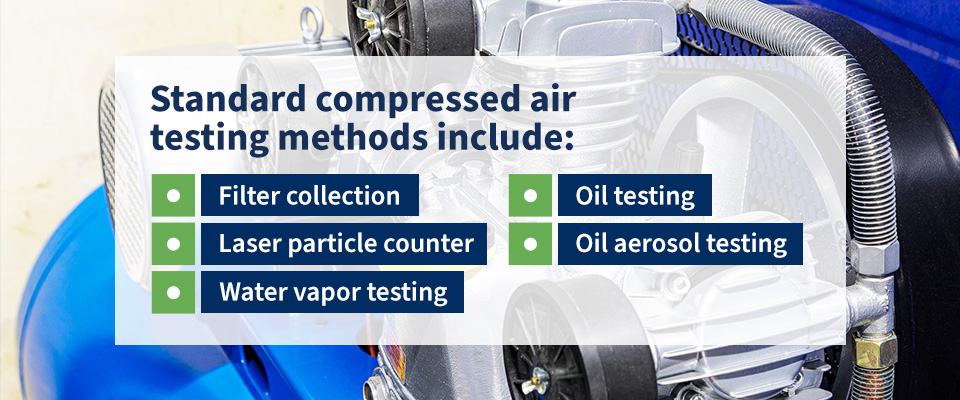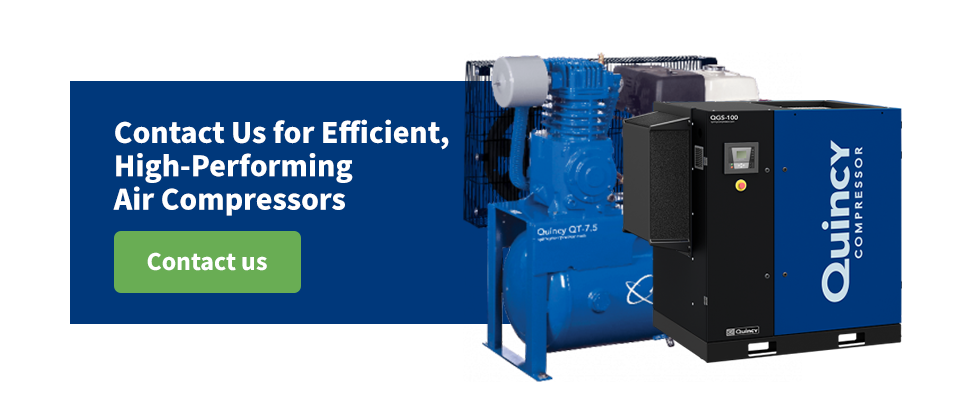Air compressor efficiency is a priority for many organizations. Knowing how well your air compressors perform is an excellent indication of their overall efficiency. Any facility that runs at limited efficiency will use more power to achieve the same results. In fact, only 10-20% of the energy required to generate compressed air reaches the point of use.
Making your air compressors more efficient is essential. System pressure is one of the most critical indicators. Air compressor performance tests are only one element of the process. Other aspects of the system can also impact performance and efficiency. A holistic view of system performance can boost efficiency, save money and reduce environmental impact.
Why Is Air Compressor Efficiency Important?
The need to reduce energy consumption and maximize efficiency exists in all industries. Although much can be done in design and manufacturing, reducing demand-side inefficiencies is critical to overall performance. Maintaining air compressor efficiency has many benefits, including:
- Boost system longevity: The causes of inefficiencies are often easy to fix. Unattended, they can cause excess wear to your system, as the compressor has to work harder to meet your energy requirements. The harder the system works, the more that strain wears out the components. Keeping an air compressor efficient throughout its useful life can reduce maintenance requirements and boost the system’s longevity.
- Reduce costs: Efficient air compressors can help you manage compressed air usage and save on energy costs, since they offer peak performance without extra power. Reduced operational costs can maximize profits, meeting the primary goal of any business strategy.
- Increase sustainability: Limiting energy use lowers your emissions, contributing to your sustainability goals. By prioritizing energy efficiency, you can ensure you’re proactive in limiting environmental harm, improve your reputation and even boost sales among environmentally conscious groups.
How to Measure Air Compressor Performance
The first step to making an air compressor more efficient is to measure its current performance. You must be able to measure power consumption, compressed air delivery levels and pressure profiles to gain clear insights into the equipment’s overall performance.
Depending on your project and air compressor type, you can use two air compressor calculations.
The Reciprocating Compressor Efficiency Formula
A reciprocating compressor’s capacity depends on the volume that the pistons displace during movement. Calculate the swept volume of a piston with the following formula:
Vd = St . (πD2) / 4
- Vd: Swept volume
- St: Piston stroke
Volumetric efficiency must account for actual volume and swept volume. It’s best to consult an expert for accurate calculations. You can get a quick estimation of volumetric efficiency with the following formula:
Ev = 0.97 – c . (τ 1 / k – 1) – L
- Ev: Volumetric efficiency
- c: Clearance
- k: Isentropic coefficient
- L: 0.04 for lubricated compressors as an estimation
From there, multiply the value by the number of cylinders to learn the capacity of your reciprocating compressor.
The Free Air Delivery Formula
Free air delivery (FAD) is the expanded volume of air that the equipment forces into its network over time. The ISO 1217:2009 standard specifies the compressor FAD calculation, which includes measuring the following:
- Temperature, atmospheric pressure and humidity conditions at the air inlet
- Maximum operating temperature, pressure and compressed air volume at the unit outlet
Use the following equation to calculate FAD:
F1 = P1 – (Pp . Frel)
- F1: Free air delivery
- P1: Inlet pressure
- Pp: Vapor pressure
- Free: Inlet humidity
How Do You Calculate FAD From Discharge Flow?
If you measure discharge flow with a pitot tube, take additional measurements to compute it into FAD. The operating flow at the discharge includes two components — air flow and water flow. You need to measure the humidity in the pipe for precise water content measurements, which can be challenging since many humidity sensors are designed to work in less severe environments.
With the right equipment, you can use a constant settling for relative humidity and deduct the water contents from the flow to calculate “dry air” flow.
Compressed Air Testing Methods
Compressed air tests are standardized procedures to ascertain the quality of compressed air. They routinely test for contamination from ambient air, impurities from compressor parts and lubrication, and inbuilt contaminants from piping and storage components. The ISO 8573-1:2010 compressed air quality standard serves as a valuable guideline for industries requiring specific air quality.

Standard compressed air testing methods include:
- Filter collection: This technique uses an optical microscope to analyze particles within a compressed air sample.
- Laser particle counter: This specialized device can sample compressed air in line with ISO 8753 standards. It provides rapid analysis of particles of all size ranges.
- Water vapor testing: This method detects water vapor impurities in compressed air samples in several ways, including hygrometers, detector tubes and spectroscopy.
- Oil testing: Testing for various hydrocarbon compounds, including oil, condensed hydrocarbons and oil vapor.
- Oil aerosol testing: In this method, oil from compressed air samples is dissolved on high-efficiency membranes using a solvent. Then, it is analyzed using infrared spectrometry.
Your choice of testing method depends on the air quality your application requires. Quality air compressors can provide the required air quality while maintaining efficiency to cut costs and reduce environmental impact.
How to Use Key Performance Indicators for Maximum Efficiency
Key performance indicators (KPIs) are a quantifiable measure of performance used in many industries. You can adjust them to meet your criteria and provide an accurate overview of how your air compressor meets your efficiency objectives. KPIs can help you:
- Determine system efficiency.
- Set a baseline before integrating changes or improvements.
- Justify improvement projects.
- Prove project results.
- Maintain savings.
- Monitor waste levels.
- Detect upcoming performance problems.
What KPIs Can You Use to Measure Performance?
KPIs help you measure air compressor performance and efficiency. Depending on your primary objective, you can choose several options to ensure you have the right information, including:
- Pressure: Screw compressor power consumption increases by ½ a percent and unregulated compressed air flow increases by 1 percent for each psi in discharge pressure. It can be helpful to measure discharge pressure as an indicator of efficiency.
- Dewpoint: Tracking the dewpoint of compressed air ensures your drying equipment performs optimally and maintains compressed air quality.
- Power: Measuring power consumption is an excellent indicator of air compressor efficiency. Installing power measurement meters on each air compressor can be instrumental in calculating your system’s total operating costs.
- Flow: You can learn whether your compressed air system is performing efficiently by measuring and logging compressed air flow. Measuring flow can be challenging, but recent innovations have made measuring thermal mass flow more affordable even for small systems.
- Temperature: High ambient temperature can lead to air quality problems due to condensation. Consider monitoring the room and compressed air temperatures to alleviate the strain on your dryer system and reduce condensation.
- Leakage: Minimizing leakage is critical to boost air compressor efficiency. Efficient systems can only produce cost-effective compressed air when system leaks and the accompanying waste are under control. If you can track waste and set trigger points, you can introduce maintenance plans to limit leakage.
- Annual carbon emissions: Efficiency and sustainability go hand in hand. Knowing your system’s energy consumption means you can calculate and track your equivalent annual carbon emissions and savings based on improvements.
Contact Us for Efficient, High-Performing Air Compressors
Quincy Compressor has been delivering highly efficient air compressors since 1920. We manufacture reciprocating and rotary screw air compressors to the highest possible standards, providing the durability and performance our customers have come to expect. Contact us today and start transforming your operations.


